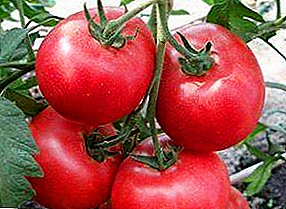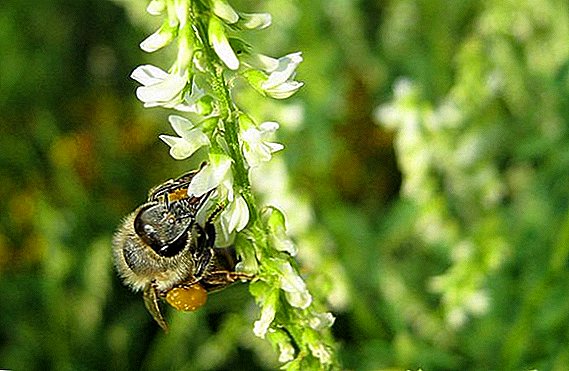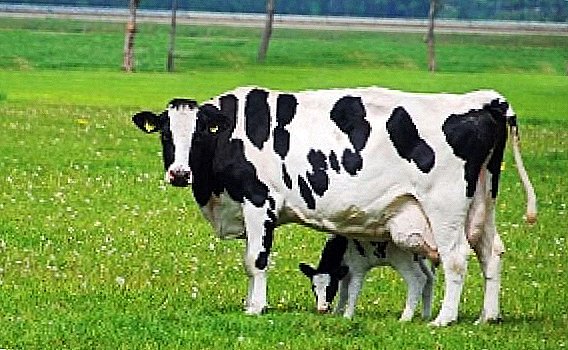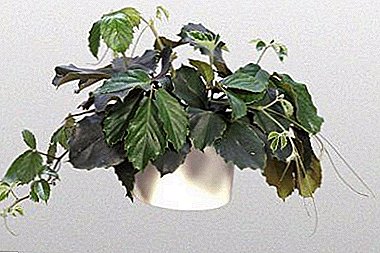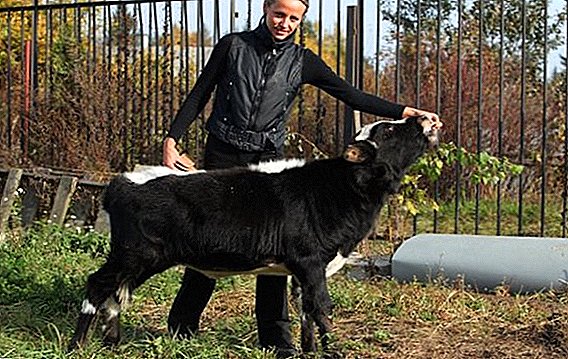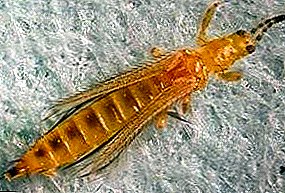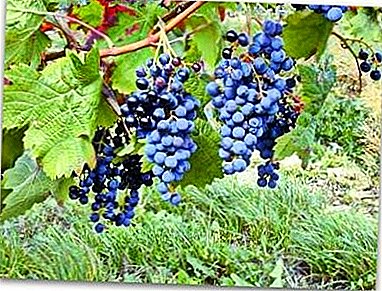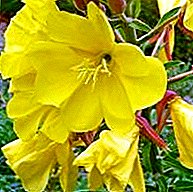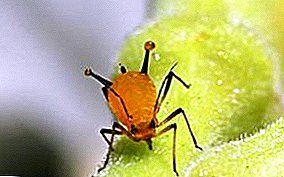
Beef is an indispensable source of energy for a person, since it is this meat that best of all satisfies the needs of the body for the essential trace elements and vitamins.
Cows and bulls of meat breeds, as a rule, are very large, they grow quickly, and their meat is high in calories.
Meat cows almost do not give milk, and in weight gain more than females of the dairy or meat and dairy areas.
For quite a long time of cultivation, a number of breeds were identified, which in the best way reflect the goal for the sake of which these cattle are bred and reared.
Description of these breeds you can find in this material.
Hereford breed of cows

The Hereford breed is one of the most famous and popular breeds of meat in the world.
The color of these animals is dark red, but the head, withers, belly, dewlap, tail brush and lower half of the limbs are painted white. The nose of these cows is pale pink.
The constitution of representatives of this breed is typically meat. The animal reaches an average height of 125 cm, and a length of 150-155 cm. The body has the shape of a barrel, it is rather squat, deep and wide.
Fench is strong, therefore it can be clearly seen from the side. The sternum is wide and set deep. The back and loin are wide but short. The horns are rather thick, but small. The skin is covered with small soft hairs, very thin, elastic in structure.
Bulls can gain in weight from 850 to 1000 kg, and heifers - from 550 to 650 kg.
It is very easy to fatten animals of this breed, they are extremely favorably affected by walking their pasture. The meat of these cows and bulls is very high quality, is the standard of "marble" meat. At slaughter about 58-62% of the total weight of the animal will be meat, ready for use and consumption.

Hereford cows are not demanding to care, they can cover quite long distances, are not exposed to certain diseases, and are also capable of rapid acclimatization.
They have very calm temperamentthey live very long - 15-18 years.
During all the years of life, animals do not lose a lot of weight, and fertility also stays on the level.
There are a number of experiments that were carried out on these cows. As a result, it was concluded that the animals of this breed on the pasture eat almost all types of grass, regardless of its roughness. These cows eat even weeds.
The only disadvantage of this breed is that calves are born small, only 25 kg of live weight. But their bodies are strong enough not to get sick.
For additional protection of young stock on the floor of the barn you need to put a lot of dry litter. Then the calves will not be afraid of any cold. Hereford cows are not milked, since their milkiness is very low. Calves are kept on the suction, but for the entire period of lactation can be obtained from one cow 1000-1200 kg of milk, the fat content of which is about 4%.
Belgian Blue Cow

The Belgian blue cow is rightfully considered the most promising breed in the world. It was withdrawn a long time ago, in the 19th century in the open spaces of Belgium. Since then, animals of this breed are actively bred to produce high quality meat.
The animals of this breed are rather large, the forms are round, the muscles are expressed very clearly. Subcutaneous muscles are particularly visible in the areas of the neck, shoulders, pelvis, rump and lower back.
The back of these cows is straight, the rump is round, the tail is very clearly marked, the skin is very elastic and healthy looking. These cows are very well developed legs, therefore they can easily move, overcoming the big distances.
Coloring can be very diverse, but within the color group, because of which the breed got its name.
The skin can be white, bluish-pegovoy, black or have shades of all previous colors. Sometimes these blue cows may have red spots, but this color is transmitted by a separate genotype. These animals are very calm due to their nature.
Bulls in the prime of their strength can weigh 1100-1250 kg, but sometimes the weight can exceed 1300 kg. a high bull can vary from 145 to 150 cm. Cows gain an average weight of 850–900 kg, and reach a height of 140 cm.

A distinctive feature of this breed of cows is high degree of muscle development.
Geneticists have found that the DNA of animals of this breed contains a gene that suppresses the production of myostatin protein, which is produced by the body to suppress muscle growth after reaching a certain point.
It is because of the presence of this gene that the muscles in this breed of cows practically never stop growing. The DNA of purebred Belgian cows contains a double copy of this gene, thanks to which, when crossed, the young will also continuously grow muscle mass.
Calves do not have such developed muscles from birth, and they begin to gain muscle mass 4 to 6 weeks after birth.
Due to its distinctive feature, Belgian cows have the biggest meat yield from carcass - about 80%. Moreover, this beef will be almost dietary due to the reduced amount of fat that accumulates in the body of this cow.
Auliekol breed of cows

Auliekol breed of cows was bred relatively recently, at the end of the 20th century, on the territory of Kazakhstan. In order to obtain this breed, breeders crossed several breeds, namely, Charolais, Aberdeen-Angus and local Kazakh white-headed breed.
For 30 years, livestock specialists managed to bring the meat of these cows to the level of high quality standards, thanks to which today auliekolsky cows are bred on large industrial farms.
Most of the representatives of this breed (about 70%) are komolymi, that is, they have no horns.
The skin of these cows is light gray, the constitution is strong, barrel-shaped torso. In winter, a thick pile appears on the skin, which protects the cow's body from hypothermia. It is because of the presence of this hair, auliekolskie cows calmly endure severe frosts without significant weight loss.

These cows grow and develop very quickly. An adult bull can weigh 950-1050 kg, and a cow can gain a weight of about 540 - 560 kg.
It so happens that the bull can "eat" 1500 kg of body weight.
Meat these cows are of high quality, "marble", contains not a lot of fat. When slaughter meat output is 60-63%. Meat of these cows enjoys special demand in the markets of Kazakhstan.
Auliekol cows are very adapt quickly to any, even very changeable, weather conditions. An interesting fact is that the skin of these cows can stratify into 4-5 layers, when other breeds have the maximum number of layers that can reach only 3.
These cows do not require special conditions for housing, and almost any type of vegetation can be eaten on pasture.
It is also interesting to read about the features of milking a cow.
Kian cows

Kyan cows were bred in the Val di Chiana valley in Italy. This breed is recognized as the largest in the world.
In the CIS, these animals appeared relatively recently, at the end of the last century. Since then, the Kian breed cows can be seen on many farms, and not only industrial ones.
Cows of this breed painted white, but sometimes you can see animals with a light gray skin tone, and in bulls the chest is generally gray.
The bones of these animals are thin, the head is medium in size, the profile is straight, the horns are small. The withers are high enough, the sternum is wide, the muscles on it are excellently developed, the dewlap is moderately developed, the body is elongated, the loin and back are wide, the muscles are very well developed, the sacrum is even and long, the legs are long and straight.
The skin of these cows is soft and thin.
Despite the color of adults, calves at birth are colored in red. As such, they remain until such time as they are 3 months old.

Bulls can reach a height of 158 cm, and heifers - 172 cm. In length, cows grow up to 170 cm, and bulls - up to 195 cm. Cows can gain 720 - 1000 kg of live weight, and bulls - 1300-1800 kg.
The milk production of this breed of cows is extremely low. The weight of a newborn calf is 42-48 kg.
Six months after birth, with normal development, proper maintenance and nutrition, the calf can gain up to 220 kg of body weight. During the day a young cow or bull is gaining an average of 1 - 1.4 kg. At slaughter, the percentage yield of meat is about 60-65%.
Unfortunately, this breed of cows has a number of drawbacks. For example, animals of this breed have a violent temperament, therefore, can kick a person, as well as bite and hit with a horn. They are also overly active, so they can jump over a fence, the height of which can reach 2 m.
White Aquitanian breed

The white Aquitaine breed of cows was selenced in Aquitaine, France. It was obtained by crossing Goransky, White Pyrenean breeds and cow Querci.
White Aquitaine cows are considered one of the most valuable, since for the entire period of its cultivation, livestock specialists have ensured that the meat of these cows meets the most stringent criteria for quality selection.
The skin color of a cow can vary from red to white. The most typical are golden and wheat shades, while the circles around the eyes, the inner side of the thigh, the stomach and the shin may be white.
The shape of the head of these cows is elongated, the muzzle and forehead are wide, the face is triangular in shape. Horns may or may not be present. They themselves are quite thick, at the base - light, and at the tips - dark.

Purebred white Aquitanian bulls can weigh from 720 to 1200 kg, but sometimes the weight can reach up to 1400 kg. Cows can gain 630-820 kg.
Animals of this breed are very hardy, can withstand both the most severe frosts, and intense heat.
Muscle both in bulls and in chicks develop very activelyespecially in the front and rear legs.
These cows are very calm in nature, their maintenance does not require much trouble in the issue of "education".
The meat of these cows is red and low in fat. With one carcass you can get from 65 to 70% of truly dietary meat.
Charolais breed

Charolais breed cows were bred in France. These animals are prone to prolonged muscle building, which makes it possible to get a lot of low-fat meat at slaughter.
Sharolese cows are quite large, grow rapidly, actively gaining muscle mass, are capable of rapid acclimatization. The color of these cows can take on shades from white to yellow.
The scalp on the skin is extremely weak. The head of the animals is short, the forehead is wide.
The neck is fleshy, short. The chest is set deep enough, the back almost does not sag.
In the back of the body are very well developed muscles. The legs are straight, of medium length, the average height of one cow is 135 cm, in a bull - 143 cm.

Often, these cows split the scapula, the back takes on an irregular shape, and the back of the body is prone to hypertrophy. Therefore, it is very difficult for sharolez cows to give birth to calves.
Despite these shortcomings, these cows live long enough. Throughout life, cows are able to give birth to calves. Bulls live an average of 15 years, in heifers - 13-14 years.
During fattening, cows develop more muscle tissue, not fatty tissue, which makes meat really low-calorie.
Bulls are able to gain 1 - 1.2 tons of weight, and heifers - 0.6 - 0.7 tons. Charolais belongs to meat breeds, but these cows also have high milk yield, and not only during lactation.
Further, the choice is yours. Feel free to buy the cow that fit you by description. After a while you get a lot of quality marbled beef.


